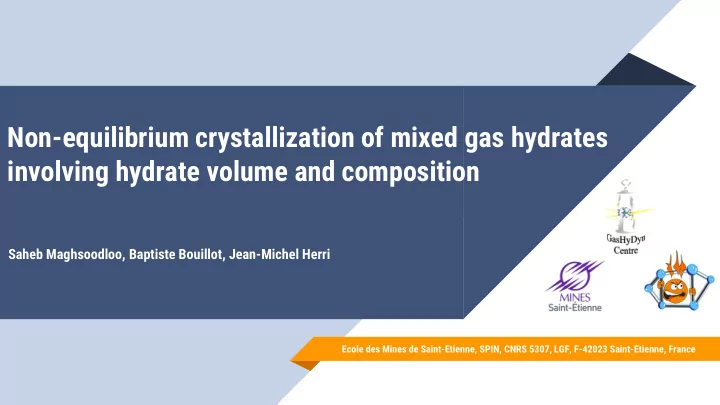

Non-equilibrium crystallization of mixed gas hydrates involving hydrate volume and composition Saheb Maghsoodloo, Baptiste Bouillot, Jean-Michel Herri Ecole des Mines de Saint-Etienne, SPIN, CNRS 5307, LGF, F-42023 Saint-Etienne, France
Introduction and Problematics What roles do clathrate hydrates play? When and how much (volume) do gas hydrates form? Flow assurance Energy resources Gas separation Water desalination Is thermodynamic equilibrium reached? CO 2 capture and Gas storage and sequestration transportation How does the rate of crystallization affect the final state? Thermodynamics and crystallization mechanisms of clathrate hydrates 2
Experimental section Materials Set-up Procedures P CH 4 -C 3 H 8 C 2 H 6 -C 3 H 8 1. Cryostat 2. Reactor 2L, 100bar Quick Slow 3. Windows 12 * 2cm 4. Gas bottles CO 2 -C 3 H 8 5. Agitator 6. Temperature sensors Pt 100 7. Sampling liquid 8. HPLC pump T 9. Granulometric sensors LASENTECH 10. Sampling gas ROLSI 11. Gas chromatograph 12. Air supply, He 13. Display pressure and temperature 14. Computer recording data 3
Results and Disscussion Hydrate Density Water Conversion +13% +32% 4
Modeling 198 Equilibrium pressure points for the mixtures involving propane Results of thermodynamic model for quick and slow crystallization vdW & Kihara Platteeuw Parameters Hydrate Equilibrium CO2-C3 Composition Pressure Slow 9,6 % 12,3 % ε Optimization a Quick 19,30 % 15,5 % σ Propane 𝜻 =195.0 σ =3.34 a=0.6502 5
Conclusion Pressure Different rate of Volume Quick crystallization Slow C 3 H 8 content Slow Less kinetic Thermodynamic crystallization effects equilibrium 6
THANKS FOR YOUR ATTENTION 7
Recommend
More recommend